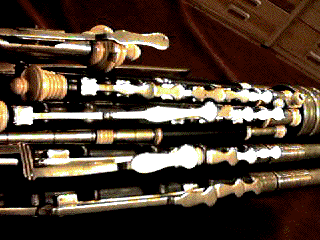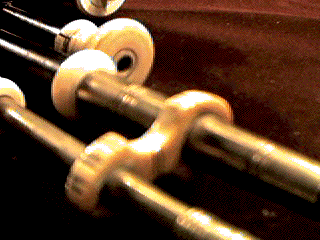Identify this Uilleann pipe!
The museum of music (Musikmuséet) in Stockholm has an Uilleann pipe on
display, which I have admired for some time. Recently, I and Stefan
Kayat (Uilleann piper from Stockholm) got the opportunity to take a
closer look at it. I took some pictures and would like your help to
identify this magnificent piece. Who built it? How old is it? Where
has it been? Any help or comments would be greatly appreciated! Send
an Email to crwth@it.uu.se.


This is a flat
set in B (an educated guess) with three drones (as usual) and 5
regulators (less usual). I would guess the instrument to have been
made in the 19th century. It was bought by the museum from a Mr. Tony
Bingham in London in 1981 and is in very good condition. Most of the
work seem to be in some fruit wood (painted black), real ivory and
nickel plated brass. The bag's main stock cup is made of horn and the
chanter stock of boxwood.
The chanter
The chanter is in ebony, is 44.3 cm long (17.4 inches) from the reed
seat to the end and has 7 keys + a stop key. The reedcap is fed with
air from the top, not from the side. The keys seem to be (from bottom
up) for the notes of Eb, F, G#, Bb, C, high D and high E.





The regulators
In addition to the three conventional regulators, the set has one
extra regulator with only one key (probably an E key). This regulator
is attached to the inner side of the stock (the side closest to your
body when you play; on the right hand side in the next picture).
The set also has one extra bass regulator - a contra bass with a
U-shaped end, adjacent to the other bass.

Note the U-connection between the two bass regulator heads. This
suggests that the air feed to both regulators goes via the outer hull
of the inner regulator (the contra bass) up to the reg heads. The bass
regulator reeds look brand new.

Close-up on the keywork, with the end of the contra bass regulator on
top with a large key. Then follows the tenor, baryton, the contra bass
regulator again (before the bend) and finally the straight bass
regulator. The extra one-keyed regulator cannot be seen, but its key
is visible in the background on top.

Another close-up. On top is the end of
the contra bass regulator. Below that (to the far left) is the end of the
extra one-keyed regulator. The two other ends are of the tenor and
baryton. The shining wooden object in the background is the bellows.
You may have noticed a small patch on the end of the contra bass
regulator on top. It is a small piece of cork, probably intended to
protect the ivory from the key when it is pressed, but the end is not
turned correctly for this to work.

The backside of the drones and regulators. The extra one-keyed regulator can
be seen on top.
The bellows

The bellows have a metal hinge and the air hose is permanently fixed.
More pictures

The end of the bass drone


The drone switch

The main stock cup, made of horn. The bag seems to be rather new and is
extremely small for such a large set.
Please mail me if you have any
comments which would help identifying this set. I have found no
markings on the set identifying the maker.
The most popular and well founded guess I have seen so far among the
answers that dropped in, is that the set was built by Maurice Coyne
around 1850. Here are som arguments in favour of this guess:
"The fact that there is a fourth regulator is interesting if not unique
for this maker."
/Ken McLeod (referring to the regulator with only one key)
"The ivory piece on the bend of the bass drone is a feature of some
Coyne pipes."
/Ken McLeod
"The shape of the regulator keys is typically that of Maurice Coyne."
/Wilbert Garvin
"You said it isn't stamped with a maker's name. Again typical of
Coyne."
/Ken McLeod
"Very similar keywork, mounts, a fourth reg with one key, same
extended bass reg, mainstock ferrule design the same, same wierd stop
key on the head with the creative bends around the ivory mounts."
/Mark Walstrom (comparing to a known M.Coyne set described
in 'The Story of the Bagpipe' by Flood)
"They are either Maurice Coyne or a very clever copy of his turning
style. The stock cup is a design of Timothy Kenna which fits. Coyne
learnt the trade from Kenna after all."
/Ken McLeod
Olle Gällmo
Department of Computer Systems Email: crwth@it.uu.se
Box 325 URL: http://user.it.uu.se/~crwth
S-751 05 Uppsala Phone: +46 18 471 10 09
Sweden Fax: +46 18 55 02 25